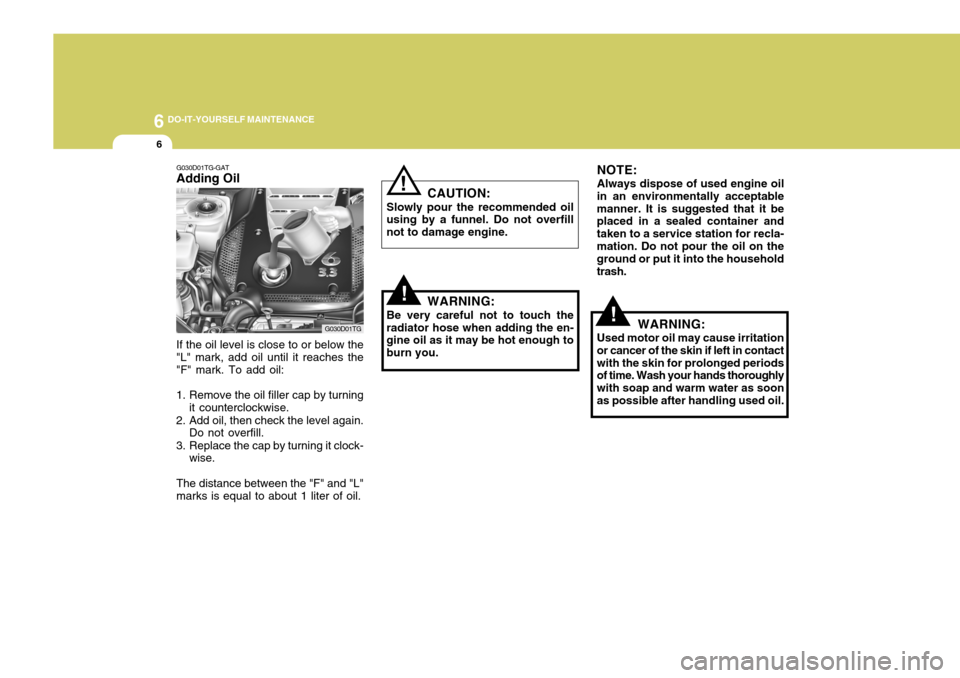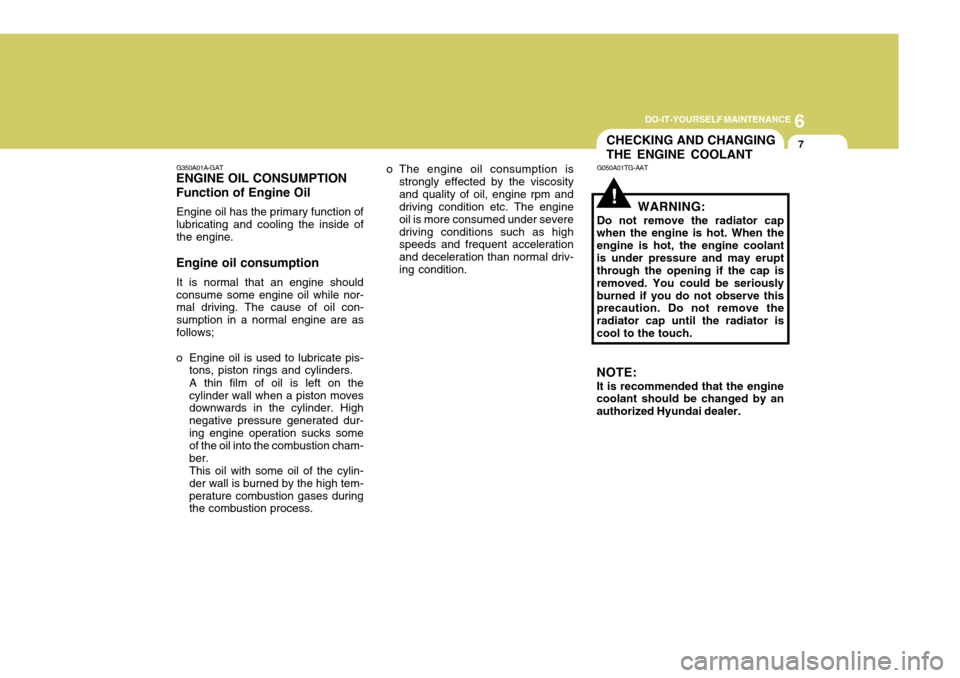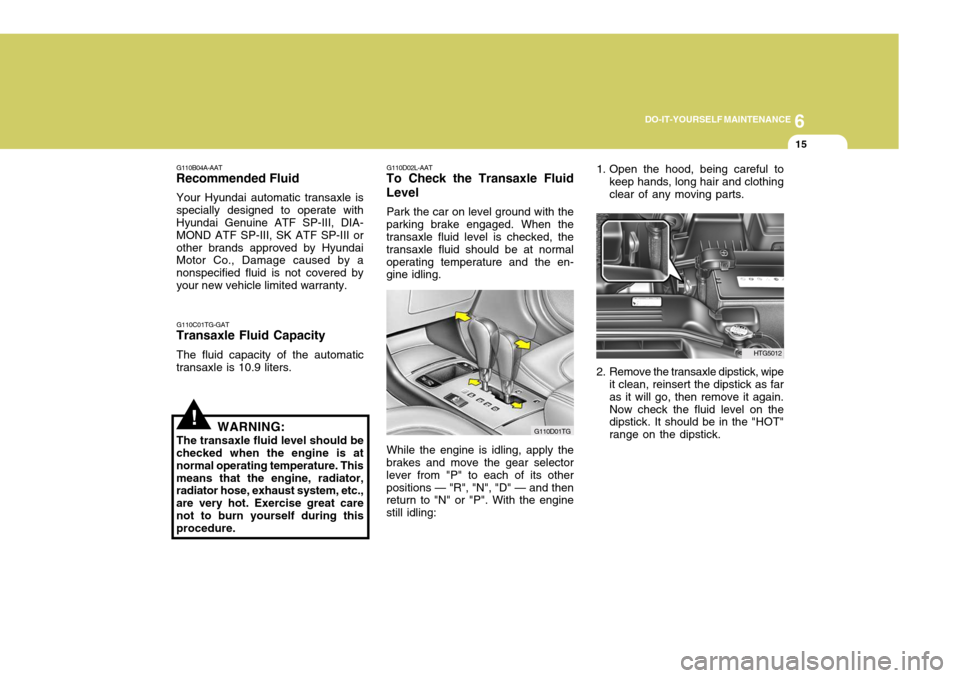2005 Hyundai Azera radiator cap
[x] Cancel search: radiator capPage 88 of 297

1
FEATURES OF YOUR HYUNDAI
71
The needle on the engine coolant tem- perature gauge should stay in the nor-mal range. If it moves across the dial to "H" (Hot), pull over and stop as soon as possible and turn off the engine. Thenopen the hood and check the coolant level (See "If the engine overheats" on the page 3-4.) and the water pumpdrive belt . If you suspect cooling sys- tem trouble, have your cooling system checked by a Hyundai dealer as soonas possible. B300A01A-GAT SPEEDOMETER Your Hyundai's speedometer is cali- brated in kilometers per hour or milesper hour.B300A01TG
B300A02TG
Conventional Type
Supervision Type
!
B290A03A-AAT ENGINE COOLANT TEMPERATURE GAUGE
WARNING:
Never remove the radiator cap when the engine is hot. The engine cool-ant is under pressure and could erupt and cause severe burns. Wait until the engine is cool before re-moving the radiator cap. B290A01TG
Conventional Type Supervision Type
Page 120 of 297

1
FEATURES OF YOUR HYUNDAI
103
!WARNING:
o Fuel vapors are dangerous. Be- fore refueling, always stop the engine and never allow sparks oropen flames near the filler area. If you need to replace the filler cap, use a genuine Hyundai replace-ment part. If you open the fuel filler cap during high ambient tempera-tures, a slight "pressure sound" may be heard. This is normal and not a cause for concern.Whenever you open the fuel filler cap, turn it slowly. HTG2023
REMOTE FUEL-FILLER LID RELEASE
B560A02NF-GAT The fuel-filler lid may be opened from inside the vehicle by pushing on thefuel-filler lid opener located on the driver side door. NOTE: If the fuel-filler lid will not open because ice has formed around it, tap lightly or push on the lid tobreak the ice and release the lid. Do not pry on the lid. If necessary, spray around the lid with an ap-proved de-icer fluid (do not use radiator anti-freeze) or move the vehicle to a warm place and allowthe ice to melt. HTG2022HIGH-MOUNTED REAR STOP LIGHT
B550A01A-AAT In addition to the lower-mounted rear stop lights on either side of the car, the high mounted rear stop light in thecenter of the rear window also lights when the brakes are applied. B550A01TG
Page 211 of 297

3 WHAT TO DO IN AN EMERGENCY
4
!
!
IF THE ENGINE OVERHEATS
(If the air conditioning had been in use, it is normal for cold water to bedraining from it when you stop).
D030A01TG-AAT If your temperature gauge indicates overheating, you experience a loss of power, or hear loud pinging or knock- ing, the engine is probably too hot. Ifthis happens to you, you should:
1. Pull off the road and stop as soon as
it is safe to do so.
2. Place the gear selector lever in "P"
and set the parking brake. If the air conditioning is on, turn it off.
3. If engine coolant is running out under
the car or steam is coming out fromthe hood, stop the engine. Do not open the hood until the engine coolant has stopped running or thesteaming has stopped. If there is no visible loss of coolant and no steam, leave the engine running and checkto be sure the engine cooling fan is operating. If the fan is not running, turn the engine off.
4. Check to see if the water pump drive belt is missing. If it is not missing,check to see that it is tight. If thedrive belt seems to be satisfactory, check for engine coolant leaking from the radiator, hoses or under the car.
6. Carefully remove the jumper cables
in the reverse order of attachment.
If you do not know why your batterybecame discharged (because the lightswere left on, etc.), have the charging system checked by your Hyundai dealer. WARNING:
While the engine is running, keephands and clothing away from mov-ing parts such as the fan and drive belts to prevent injury.
5. If the water pump drive belt is broken or coolant is leaking out, stop theengine immediately and call the near- est Hyundai dealer for assistance.
WARNING:
Do not remove the radiator cap whenthe engine is hot. This can allow coolant to be blown out of the open- ing and cause serious burns.
Page 238 of 297

6 DO-IT-YOURSELF MAINTENANCE
2
G010A01TG-GATENGINE COMPARTMENT
G010A01TG
CAUTION:
When inspecting or servic- ing the engine, you should handle tools and otherheavy objects carefully so that the plastic cover of the engine is not damaged.
!
1. Coolant reservoir cap
2. Engine oil filler cap
3. Air cleaner
4. Brake fluid reservoir 5. Fuse and relay box
6. Windshield washer fluid reservoir
7. Power steering fluid reservoir
8. Engine oil level dipstick 9. Automatic transaxle oil level dip-
stick
10. Radiator cap
11. Battery
Page 242 of 297

6 DO-IT-YOURSELF MAINTENANCE
6
!
!
CAUTION:
Slowly pour the recommended oil using by a funnel. Do not overfill not to damage engine.
WARNING:
Be very careful not to touch theradiator hose when adding the en- gine oil as it may be hot enough to burn you.! NOTE: Always dispose of used engine oil
in an environmentally acceptable manner. It is suggested that it be placed in a sealed container and taken to a service station for recla-mation. Do not pour the oil on the ground or put it into the household trash.
WARNING:
Used motor oil may cause irritationor cancer of the skin if left in contactwith the skin for prolonged periods of time. Wash your hands thoroughly with soap and warm water as soonas possible after handling used oil.
G030D01TG-GAT Adding Oil If the oil level is close to or below the "L" mark, add oil until it reaches the "F" mark. To add oil:
1. Remove the oil filler cap by turning it counterclockwise.
2. Add oil, then check the level again. Do not overfill.
3. Replace the cap by turning it clock- wise.
The distance between the "F" and "L" marks is equal to about 1 liter of oil. G030D01TG
Page 243 of 297

6
DO-IT-YOURSELF MAINTENANCE
7
G350A01A-GAT
ENGINE OIL CONSUMPTION Function of Engine Oil
Engine oil has the primary function of lubricating and cooling the inside of the engine.
Engine oil consumption It is normal that an engine should consume some engine oil while nor- mal driving. The cause of oil con- sumption in a normal engine are asfollows;
o Engine oil is used to lubricate pis- tons, piston rings and cylinders. A thin film of oil is left on the cylinder wall when a piston moves downwards in the cylinder. High negative pressure generated dur-ing engine operation sucks some of the oil into the combustion cham- ber.This oil with some oil of the cylin-der wall is burned by the high tem-perature combustion gases during the combustion process. o The engine oil consumption is
strongly effected by the viscosity and quality of oil, engine rpm and driving condition etc. The engine oil is more consumed under severedriving conditions such as high speeds and frequent acceleration and deceleration than normal driv-ing condition.
!
CHECKING AND CHANGING THE ENGINE COOLANT
G050A01TG-AAT
WARNING:
Do not remove the radiator cap
when the engine is hot. When the engine is hot, the engine coolantis under pressure and may erupt through the opening if the cap is removed. You could be seriouslyburned if you do not observe this precaution. Do not remove the radiator cap until the radiator iscool to the touch.
NOTE: It is recommended that the engine coolant should be changed by an authorized Hyundai dealer.
Page 251 of 297

6
DO-IT-YOURSELF MAINTENANCE
15
!
1. Open the hood, being careful to
keep hands, long hair and clothing clear of any moving parts.
2. Remove the transaxle dipstick, wipe it clean, reinsert the dipstick as faras it will go, then remove it again.Now check the fluid level on the dipstick. It should be in the "HOT" range on the dipstick. HTG5012
G110C01TG-GAT
Transaxle Fluid Capacity
The fluid capacity of the automatic
transaxle is 10.9 liters.
WARNING:
The transaxle fluid level should be
checked when the engine is atnormal operating temperature. Thismeans that the engine, radiator, radiator hose, exhaust system, etc., are very hot. Exercise great carenot to burn yourself during this procedure. G110D02L-AAT
To Check the Transaxle Fluid Level
Park the car on level ground with the
parking brake engaged. When the transaxle fluid level is checked, the transaxle fluid should be at normaloperating temperature and the en- gine idling.
While the engine is idling, apply the
brakes and move the gear selector lever from "P" to each of its otherpositions — "R", "N", "D" — and then return to "N" or "P". With the engine still idling:
G110D01TG
G110B04A-AAT
Recommended Fluid
Your Hyundai automatic transaxle is specially designed to operate with Hyundai Genuine ATF SP-III, DIA- MOND ATF SP-III, SK ATF SP-III orother brands approved by Hyundai Motor Co., Damage caused by a nonspecified fluid is not covered byyour new vehicle limited warranty.